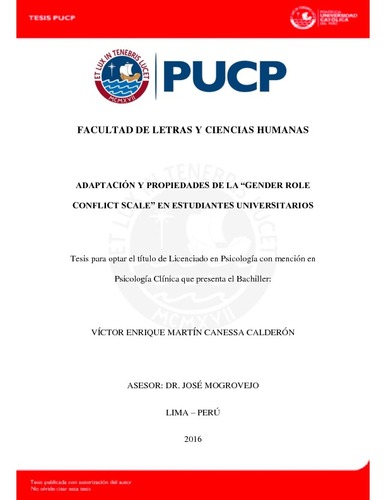| dc.contributor.advisor | Mogrovejo Sánchez, José A. | es_ES |
| dc.contributor.author | Canessa Calderón, Víctor Enrique Martín | es_ES |
| dc.date.accessioned | 2016-11-11T21:54:02Z | es_ES |
| dc.date.available | 2016-11-11T21:54:02Z | es_ES |
| dc.date.created | 2016 | es_ES |
| dc.date.issued | 2016-11-11 | es_ES |
| dc.identifier.uri | http://hdl.handle.net/20.500.12404/7470 | |
| dc.description.abstract | Antecedentes: En nuestro contexto, se han encontrado diversas problemáticas sociales referidas a la temática de género y los roles del mismo, el cual puede ser comprendido bajo una mirada binomial (masculino-femenino) o de identificaciones cruzadas. El Conflicto de rol de género, constructo creado por James O’Neil, refiere al estado psicológico en el que los roles de género tienen consecuencias negativas en uno mismo y los demás. El objetivo ha sido adaptar la escala del presente constructo, Gender Role Conflict Scale, a una población universitaria limeña, corroborando sus propiedades psicométricas en la misma población. Método: La muestra fue constituida por 210 estudiantes hombres con una edad promedio de 19.1 años. Resultados: La composición de la escala mostró comprenderse bajo los cuatro factores originales, manteniendo de manera general la estructura original. Tanto a nivel global como por factor, la escala muestra una fiabilidad aceptable, la cual oscila entre .84 y .86 según factor; así como una buena validez convergente. Conclusiones: El presente instrumento adaptado puede ser utilizado para evaluar el conflicto de rol de género en universitarios hombres limeños. | es_ES |
| dc.description.abstract | Background: Current, in Lima, we can find various social issues related to gender roles and gender itself, which can be understood under a binomial perspective (male-female) or cross-identifications. The gender role conflict, construct created by James O'Neil, refers to the psychological state in which gender roles have negative consequences for oneself and others. The aim has been to adapt the scale of this construct, Gender Role Conflict Scale, to a university population in Lima, confirming its psychometric properties in the same population. Method: The sample consisted of 210 male students with an average age of 19.1 years. Results: The composition of the scale showed the original four factors, generally maintaining the original structure. Both globally and by factor, the scale showed acceptable reliability, between .84 and .86 depending of the factor; as well as a good convergent validity. Conclusions: This adapted instrument can be used to evaluate gender role conflict in university men from Lima. | es_ES |
| dc.language.iso | spa | es_ES |
| dc.publisher | Pontificia Universidad Católica del Perú | es_ES |
| dc.rights | Atribución-NoComercial-SinDerivadas 2.5 Perú | * |
| dc.rights | info:eu-repo/semantics/openAccess | es_ES |
| dc.rights.uri | http://creativecommons.org/licenses/by-nc-nd/2.5/pe/ | * |
| dc.subject | Roles sexuales. | es_ES |
| dc.subject | Estudiantes universitarios--Investigaciones. | es_ES |
| dc.subject | Género--Perú. | es_ES |
| dc.title | Adaptación y propiedades de la "gender role conflict scale" en estudiantes universitarios | es_ES |
| dc.type | info:eu-repo/semantics/bachelorThesis | es_ES |
| thesis.degree.name | Licenciado en Psicología Clínica | es_ES |
| thesis.degree.level | Título Profesional | es_ES |
| thesis.degree.grantor | Pontificia Universidad Católica del Perú. Facultad de Letras y Ciencias Humanas. | es_ES |
| thesis.degree.discipline | Psicología Clínica | es_ES |
| renati.discipline | 313026 | es_ES |
| renati.level | https://purl.org/pe-repo/renati/level#tituloProfesional | es_ES |
| renati.type | http://purl.org/pe-repo/renati/type#tesis | es_ES |
| dc.publisher.country | PE | es_ES |
| dc.subject.ocde | https://purl.org/pe-repo/ocde/ford#5.01.00 | es_ES |






